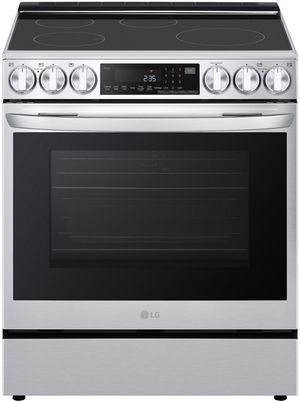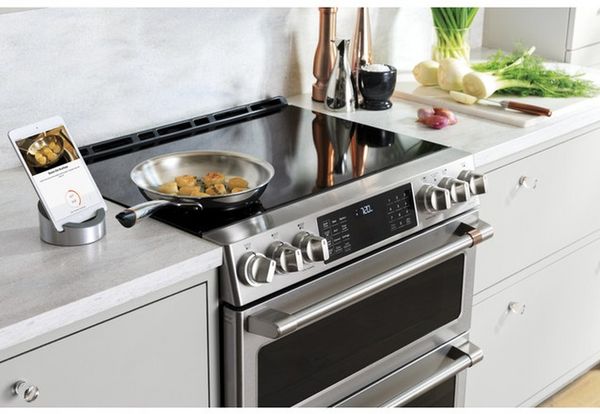
As our kitchens evolve to match the pace and precision of modern living, the appliances we choose play a major role in how we cook and interact with our space.
One of the most talked-about decisions today is whether to go with an induction or electric stove—two sleek, smooth-top options that offer convenience, consistency, and style. But despite their similar appearances, the experience they offer can be quite different.
Over the past few years, induction cooktops have seen a sharp rise in popularity thanks to their speed, efficiency, and cutting-edge safety features. At the same time, traditional electric stoves—especially radiant models—continue to be a reliable and budget-friendly choice for many households.
In this blog, we’ll walk you through a detailed comparison of induction vs electric stove technology, covering everything from cooking performance and safety to energy use and cookware compatibility. Our goal is to help you feel confident choosing the right fit for your home.
The Science Behind Induction and Electric Cooking
Looking for the basics of cooking technology explained? Electric stoves and ranges typically use radiant heating elements beneath a glass-ceramic surface. These elements heat the cooktop surface itself, which then transfers heat to your cookware through conduction. It’s a familiar and reliable method, but less efficient than induction because some heat is lost to the surrounding air and the cooktop surface.
Induction stoves, on the other hand, work using electromagnetic energy. Instead of heating the cooktop surface, they generate a magnetic field that heats the pan itself. That means the cookware becomes the heat source, not the surface beneath it. This leads to incredibly fast heat-up times and greater energy efficiency.
From a control perspective, both induction and electric stoves offer precise temperature adjustments, but induction’s responsiveness is a standout. Because there’s no thermal lag from a heating element, an induction cooktop reacts instantly when you raise or lower the heat. This difference lays the foundation for many of the performance advantages induction cooktops offer.
Which Cooks Faster: Induction or Electric?
If you’ve ever waited impatiently for water to boil on a glass-top electric stove, you’ll appreciate the speed of induction. One of the most commonly asked questions is, “Is induction cooking really faster than electric cooking?” The answer is a definitive yes.
Induction stoves can bring a pot of water to a boil in about half the time it takes a traditional electric cooktop. That’s because the energy is being delivered directly to the pot with minimal heat loss. Induction also excels at temperature accuracy and rapid changes, which is great for melting chocolate, simmering delicate sauces, or searing proteins quickly.
Electric stoves, particularly radiant models, have a slower response time because the heating element itself must heat up or cool down. That said, they’re still perfectly capable for everyday cooking, especially for tasks that don’t require lightning-fast responsiveness.
Here’s a quick comparison chart based on common cooking tasks:
| Cooking Task | Induction | Electric |
|---|---|---|
| Boiling Water | ✅ Very fast — reaches boil in minutes. | ⏳ Slower — takes longer to reach boil. |
| Simmering Sauces | ✅ Precise, stable temperature control. | ✅ Good control, slower to adjust heat. |
| Searing Meats | ✅ Rapid, even heat and quick recovery. | ⏳ Slower ramp-up; may drop heat when food is added. |
| Melting Chocolate | ✅ Excellent precision; low risk of scorching. | ⚠️ Can overheat easily; requires close attention. |
| Everyday Cooking | ✅ Efficient and highly responsive. | ✅ Reliable and consistent performance. |
Clearly, if speed and control are top priorities, induction takes the lead in the induction stove vs radiant electric debate.
Safety and Kitchen Usability
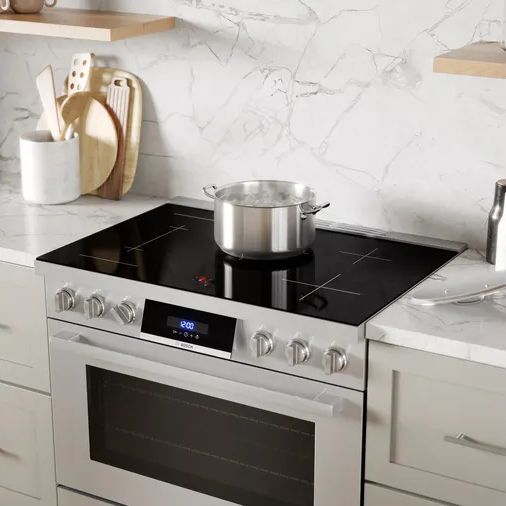
Safety is a top concern for any home chef, and here’s where induction technology really shines in induction vs electric stove comparisons. Since induction cooktops don’t heat the surface itself, the surrounding area stays relatively cool to the touch, making it a safer option in homes with kids or pets. This can help prevent burns from accidental contact and keep your kitchen cooler overall.
Most induction stoves also come with features like auto shut-off when no pan is detected and child lock controls, adding layers of protection and peace of mind. By comparison, electric stoves remain hot long after they’re turned off, and although many include indicator lights to signal hot surfaces, there’s still a risk of residual heat.
It’s also worth noting that induction cooking can produce a faint humming sound, especially on higher settings. It’s not loud, but it’s something to be aware of. And while induction is incredibly intuitive once you get used to it, there may be a slight learning curve if you’re new to the technology.
When asking, “Which is safer: an induction or an electric stove?”, we’d say induction has the edge thanks to its cool surface and smart safety features.
Cookware Compatibility and Kitchen Setup
When comparing induction vs. electric stoves, cookware requirements and installation needs are two key factors.
- Cookware for Induction: Pots and pans must be magnetic, with a base made of cast iron or certain stainless steels. A quick test—hold a magnet to the bottom; if it sticks, it’s induction-ready.
- Non-Compatible Cookware: Copper, glass, and aluminum won’t work on induction unless they have a magnetic base.
- Electric Stove Advantage: Works with nearly all cookware types, giving you more flexibility without replacing existing pieces.
- Common Question: “Do I need to replace my cookware for induction?” – Only if your current set isn’t magnetic.
- Electrical Requirements: Both induction and electric stoves typically need a 240-volt outlet, but some high-end induction models may require a dedicated circuit.
Pro Tip: Always confirm power needs with an expert before purchase and installation to avoid surprises.
In short, if your current cookware passes the magnet test, switching to induction can be simple. If not, factor the cost of new pots and pans into your decision.
Which Is More Energy Efficient: Induction or Electric?

The conversation around energy efficiency induction vs electric stove performance is crucial, especially for homeowners looking to lower their utility bills over time. Induction stoves convert about 85% of the energy they use directly into heat in the cookware. Traditional electric stoves, by comparison, are only about 75-80% efficient.
That means with induction, less energy is wasted heating the cooktop or the surrounding air. Over time, this adds up, not just in reduced power usage, but also in a cooler kitchen environment, especially in summer. However, both types of cooktops outperform gas, which only transfers energy with 32% efficiency.
It’s true that induction stoves typically come with a higher upfront price tag. But thanks to faster cooking times and better efficiency, the long-term savings often offset the initial investment. That makes induction a smart pick for eco-conscious homeowners or anyone looking to future-proof their kitchen with modern kitchen cooktops.
Top Induction and Electric Stoves to Consider
Keep reading to compare top induction vs electric stove models side by side and read reviews from customers like you.
GE Profile 30” Fingerprint Resistant Stainless Steel Slide In Induction Range
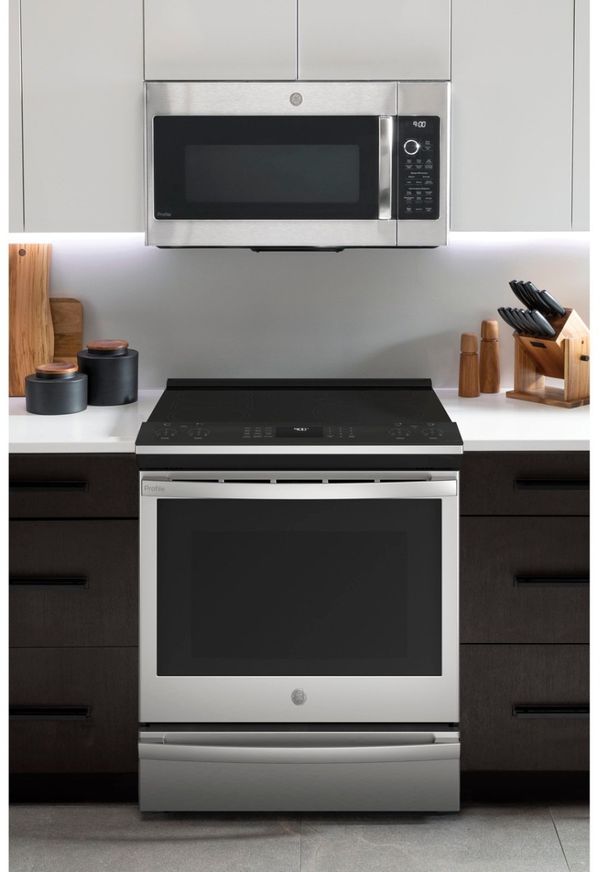
Shop GE Profile 30” Slide In Induction Range
Perfect for tech-savvy cooks and multitaskers, this GE Profile induction range blends responsive cooking with smart connectivity.
The glide touch controls and synced cooktop-microwave functions with Chef Connect simplify daily life, while the True Convection oven ensures even baking.
It’s an ideal buy for families who want fast meals and seamless kitchen tech in one sleek package.
Top Features
- Synchronized elements & Chef Connect
- Induction element boils in 101 seconds
- True Convection with Precise Air
⭐Featured GE Profile Induction Range Review:
"Our new oven heats up fast and is energy efficient. We like the layout of the controls and how easy it is to control heat."
Bosch Benchmark 30” Stainless Steel Slide-in Induction Range
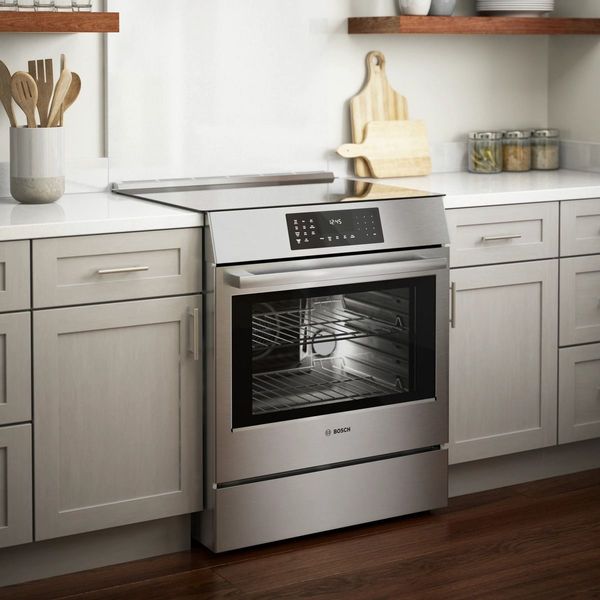
Shop Bosch Benchmark 30” Slide-in Induction Range
Engineered for serious home chefs, the Bosch Benchmark induction range delivers high-end cooking performance with its FlexInduction zones and ultra-quiet operation.
The premium design fits flush in your kitchen, while the slide-in style and self-cleaning oven simplify cleanup. It’s a great fit for style-focused homeowners who demand precision and quiet luxury.
Top Features
- FlexInduction for large cookware
- Convection Pro for even baking
- QuietClose door & premium slide-in design
LG 30” PrintProof Stainless Steel Slide In Induction Range
Shop LG 30” Slide In Induction Range
For connected households and culinary enthusiasts, this LG induction range packs in smart features and serious cooking versatility.
From Air Sous Vide to Air Fry and ProBake Convection, it handles every meal with finesse. Add ThinQ app control and InstaView for next-level convenience, making it perfect for busy families and tech lovers.
Top Features
- ProBake Convection & Air Fry
- ThinQ smart app with scan-to-cook
- Air Sous Vide for precise, juicy results
⭐Featured LG Induction Range Review:
"For two weeks, morning till night we have been using this model for holiday baking and meals. The cook top is simple to use and very easy to clean. The super boost function makes quick work of boiling water for pasta, even at 6,000 feet above sea level. The air sous vide produced moist, tender chicken. The oven baked tray after tray of perfect cookies without rotating the trays. What we would like to see changed: the controls turn on accidentally if we brush against them. Thanks for designing a wonderful appliance."
Frigidaire 30” Stainless Steel Freestanding Electric Range
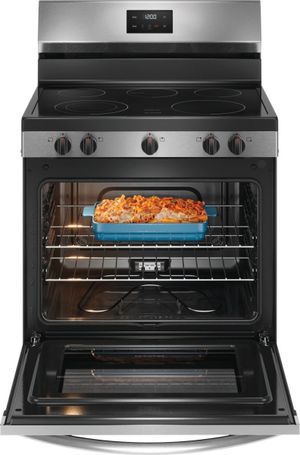
Shop Frigidaire 30” Freestanding Electric Range
Ideal for budget-conscious buyers and everyday cooks, this electric range by Frigidaire covers the basics with reliability and flexibility.
The 3,000W Quick Boil burner saves time on busy weeknights, and the five-element cooktop supports all your pots and pans. With a roomy oven and extra-wide storage drawer, it’s built to simplify daily life in a practical kitchen.
Top Features
- 3,000W Quick Boil Element
- Even Baking Technology
- SpaceWise Dual Expandable Element
⭐Featured Frigidaire Electric Range Review:
"I chose this model based on function, I.e., fully supporting cooking and baking; at any temp! I love the large control knobs, and so easy to see to read! I love the 5th element designed for warming only. The storage drawer is smaller but how tall does it need to be to hold baking sheets? I couldn't be happier. If you're looking for a solid, reliable, reasonably priced appliance, this is what you're looking for. Bells and whistles? Not so much... But who needs 'em?!"
Samsung 30” Fingerprint Resistant Stainless Steel Smart Freestanding Electric Range
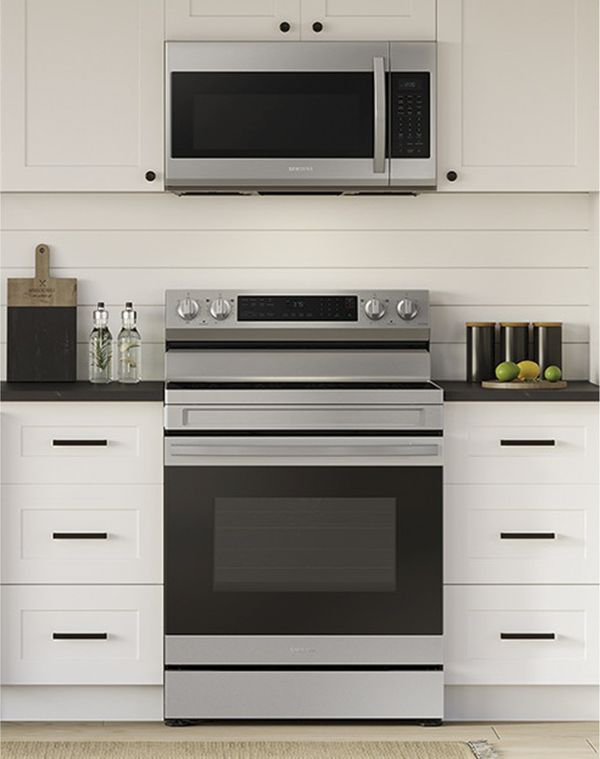
Shop Samsung 30” Smart Electric Range
Tech-forward families and modern cooks will love this stylish electric range with Wi-Fi connectivity and no-preheat Air Fry.
Its large oven capacity and convection system make hosting a breeze, while smart controls offer remote convenience.
Sleek, fingerprint-resistant surfaces ensure your Samsung electric range stays as sharp as your cooking game.
Top Features
- Air Fry with no preheat
- SmartThings Cooking & Wi-Fi controls
- 6.3 cu. ft. convection oven
⭐Featured Samsung Electric Range Review:
"This unit came with my home but it was a welcome surprise. The smart features work amazingly. If I need to prepare for dinner I'm able to. I run out and grab any last minute additions without fear of the meal burning. It also connects to my other smart devices. The design is sleek and stylish, its addition of being an airfryer also makes it great for quick meals. This would definitely be an investment no matter what."
KitchenAid 30” Stainless Steel Freestanding Electric Convection Range
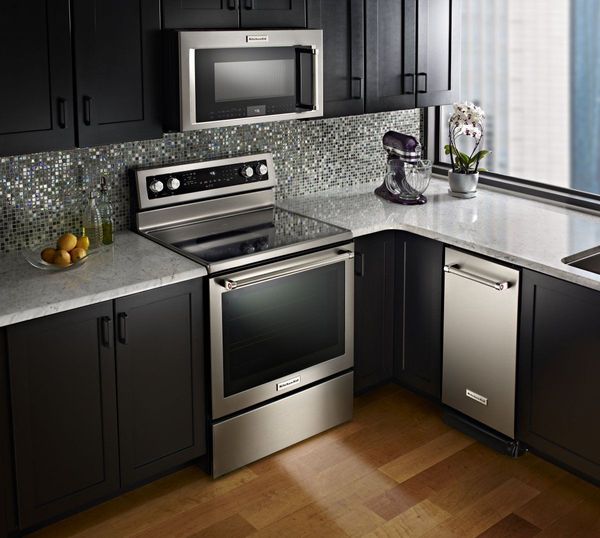
Shop KitchenAid 30” Electric Convection Range
Made for culinary creatives, this KitchenAid electric range combines pro-inspired design with intuitive features like EasyConvect Conversion and Even-Heat True Convection.
The dual-zone elements and warming zone provide cooking flexibility, while AquaLift self-cleaning offers low-odor convenience. It’s an excellent match for home chefs upgrading their workspace.
Top Features
- Even-Heat True Convection
- AquaLift low-heat self-clean
- 6.4 cu. ft. oven with dual-zone cooktop
⭐Featured KitchenAid Electric Range Review:
"I’ve been using this range for a little over a month now and I couldn’t be more pleased. The convection feature cooks everything evenly and faster than my previous oven. I love the smooth glass cooktop—it heats up quickly and is super easy to clean. The controls are intuitive, and the design looks beautiful in my kitchen. It’s been a great upgrade, and I highly recommend it to anyone looking for a reliable and stylish electric range."
Induction or Electric: Choose What Fits Your Lifestyle
When it comes to choosing between an induction vs electric stove, there’s no one-size-fits-all answer.
Induction cooktop pros and cons include faster cooking, higher efficiency, and advanced safety, as well as the need for compatible cookware and a higher upfront cost. Electric stoves remain a solid, versatile option that most households are already comfortable using, with widespread compatibility and affordability.
If you're still unsure, we invite you to visit us at Sargent Appliance online or in-store. Our experts are here to guide you through the buying process, offer personalized advice, and even help with installation logistics.
Use our stove buying guide as your launchpad to cook smarter, safer, and more efficiently than ever.
Frequently Asked Questions
The main differences in cooking performance between induction and electric stoves come down to speed, precision, and efficiency. Induction heats cookware directly through electromagnetic energy, allowing for faster boil times and more responsive temperature control. Electric stoves heat the cooktop surface first, resulting in slower heat-up and cooldown times and less energy-efficient performance.
Yes, induction stoves heat cookware directly, which drastically reduces the time it takes to boil water or reach high temperatures. Because there’s no waiting for a coil or surface to heat up, you get immediate, precise control that’s perfect for both quick meals and delicate tasks.
Possibly. If your existing cookware isn’t magnetic, it won’t work on an induction cooktop. You can test by holding a magnet to the bottom of your pans: if it sticks, they’re induction-compatible. Stainless steel and cast iron are usually a safe bet, while aluminum and copper typically are not unless they have a special base.
Induction stoves are generally safer because the cooktop itself stays cool to the touch. Heat is only generated when a magnetic pan is present, reducing the risk of accidental burns. Many models also include child locks and auto shut-off features for added safety.
In many cases, yes. While induction stoves cost more up front, their superior efficiency means you’ll save on energy bills over time. Faster cooking and reduced heat loss also make them more convenient and eco-friendly, especially for busy households and frequent cooks.
